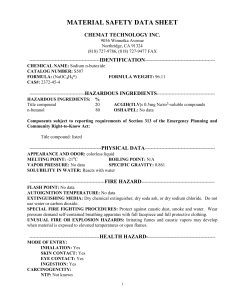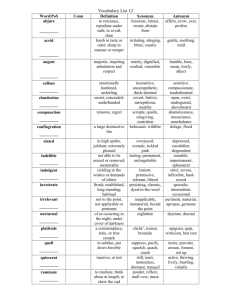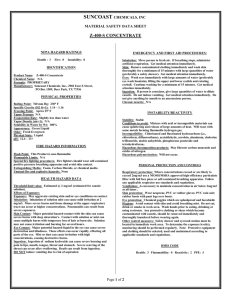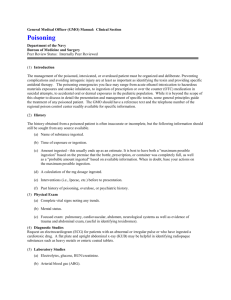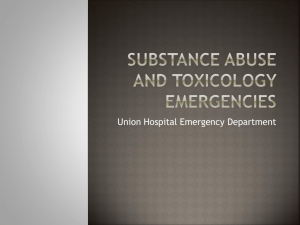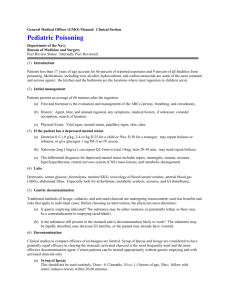Extern Conference
advertisement
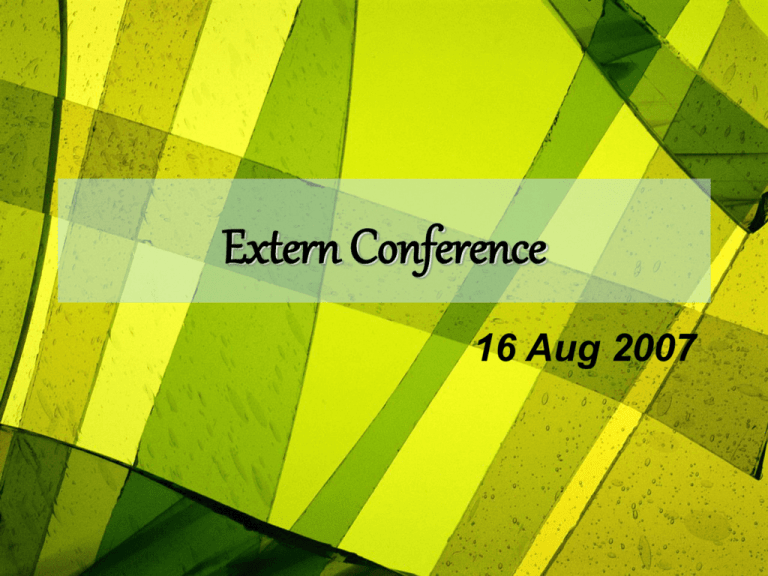
Extern Conference 16 Aug 2007 A one-year-old boy was referred to Siriraj hospital due to an accidental ingestion of unknown liquid substance for two and a half hours prior to admission. Present history 2 ½ hours PTA, the patient was brought to his uncle’s house by his father and his step-mother. While his father and his uncle were watching the television, the step-mother found that her son was drinking some amount of liquid substance from plastic bottle which was used for battery refilling. 3 Present history The child was crying and sweeping his hand over his mouth. His father washed the patient’s mouth with drinking water and gave his son some milk to induce vomiting. The patient vomited the ingested milk with sputum and saliva for 4 times. 4 Present history Before his parents brought him to a nearby hospital, he vomited some streaks of blood with gastric contents. The parents did not notice that the patient was aspirated or not. 5 Present history At emergency room, the patient was given • • • • • Activated charcoal 10 g orally Metoclopramide 2 mg intravenously Ranitidine intavenously Cetriaxone intravenously NPO Then the patient was referred to Siriraj hospital. The patient was admitted at AN 5 on 6/8/50 6 Past history • He has no underlying disease. • He has no previous history of unexplained injuries or poisoned. • He has normal developmental milestones. • He has no previous history of drugs or food allergy. 7 Family history • The patient lived with his father, his step-mother, and his grandmother. 8 Physical Examination o V/S: T 37 c, PR 148/min, RR 40/min, BP 98/72 mmHg GA: A crying Thai boy, looked distress, no pallor, no jaundice, no dyspnea, no cyanosis, no evidence of trauma, Ht 87 cm (P75-P90), Wt 11.5 kg (P50-P75) 9 Physical Examination HEENT: nose: no swelling turbinate, no discharge ears: normal tympanic membranes, both sides mouth & throat: mild dry lips, mild injected upper & lower lips, no injected oral mucosa, mild injected oropharynx 10 Physical Examination RS: no stridor, normal breath sound, no adventitious sound CVS: normal S1&S2, no murmur Abd: soft, no tenderness, active bowel sound, liver & spleen cannot palpable NS: pupil size 3 mm both RTL, otherwise unremarkable 11 Problem list 1. Ingestion of unknown liquid substance 2. Mild injected upper and lower lips with mild injected oropharynx 12 Impression • Suspected caustic ingestion 13 Management in poisoned child 1. Assessment and resuscitation 2. Diagnosis of poisoning 3. Decontamination / Enhanced elimination 4. Disposition 1. Assessment and Resuscitation • Airway : Maintain airway • Breathing : Proper ventilation and oxygenation • Circulation : Adequate perfusion • Disability : Assess level of consciousness and neurological examination 15 2. Diagnosis of poisoning • History taking : – including the containers and labels of the ingested substance • Physical Examination: Focus on – Cardiopulmonary – Respiratory – Neurological – Toxidromes • Proper investigation 16 How to obtain a poisoning history? What has been ingested? • Ask for containers of the substance, they may offer more details. • What is the substance used for? • The details of ingredients of the commercial products and medications can be obtained from the poison center. 18 Label น้ ำกลัน่ -กรด ตรำปลำทอง ใช้สำหรับเติมในแบตเตอรี่ เท่ำนั้น คำเตือน ถ้ำสัมผัสถูกสำรนี้ให้รีบใช้น้ ำสะอำดล้ำงทันที โทร : 081-xxxxxxx NOTE : Information from patient’s father The information from the manufacturer: 1.5 % Sulfuric Acid 19 How much has been intake? • Ask the parents or the caregivers who has been in the situation. • In liquid ingestion, it is noted that the amount of the ingested substance may be over reported but should not be assumed to be wrong. 20 When was it taken? • Time since ingestion • This can help you to know a time for onset of symptoms consequently you can obtain proper investigations and management. • Crucial for poisons that require blood level monitoring (example: paracetamol) 21 What symptoms or signs have been shown? • These information can help to narrow down that class of ingested substance. • Physical examination focused on cardiopulmonary, respiratory and neurological systems and look for secondary trauma : burned lips and oral cavity in the patient with caustic ingestion. • Look for the signs and symptoms of toxidromes. 22 3.Decontamination/Enhanced elimination • Gastric lavage • Ipecac • Activated charcoal • Whole bowel irrigation • Hemodialysis 23 4. Disposition • Discharge from emergency department – Intensive care unit – Ward – Nonmedical facility eg. Psychiatric 24 Recognition of child abuse • Unexplained delay in seeking treatment • Parents are uninterested by an accident • Is the history consistent each time? • Mechanism of injury inconsistent with developmental capability • Reluctance to give information or mention about previous injury. • Unexplained injury on examination. 25 Investigations (in this patient) • • • • • • BUN Cr Na+ K+ ClHCO3- 17.0 0.4 135 4.4 99 11 mg/dl mg/dl mmol/L mmol/L mmol/L mmol/L 26 CXR 1st day of admission 27 Activated charcoal Functions of activated charcoal 1. Initial toxin absorption 2. Interruption of enterohepatic circulation of toxic metabolite 3. gastrointestinal dialysis 28 Activated charcoal • Activated charcoal is being increasingly used in the management of childhood poisoning • Adsorb toxic material in the gut by offering alternative binding site 29 Activated charcoal No advantage in Alkali, Boric acid, Cyanide, DDT, Ferrous sulfate, Lithium, Mineral acids, Methanol, Malathion, Nmethyl carbamate 30 Activated charcoal Route and doses • 1 gm/kg/dose (maximum, 50-60 gm) oral • Repeated every 2-6 hrs until charcoal is passed through the rectum 31 Activated charcoal Contraindications 1. People with an obstruction of the intestines 2. Person swallowed a corrosive agent, such as a strong acid or alkali 32 Accidental caustic ingestion Accidental caustic ingestion • • • High risk group is children younger than 5 years old. Male > Female The extent and severity of the caustic injury depends on : 1. The corrosiveness of the ingested substance 2. Quantity and concentration 3. Duration of contact time 4. Subsequence secondary infection 34 Caustic agents • Caustics are typically classified as acids or alkalis. • Zinc chloride, Phenol and button battery are capable of producing severe burns even though they have near physiologic pH. • Hydrofluoric acid has not only local effects but also has fatal systemic effects eg. hypocalcemia, hypomagnesemia, hyperkalemia. 35 Caustic agents • Acid – Coagulation necrosis of tissue that produces an “eschar” to have some protective effect on deeper tissue. • Alkali – Saponification of lipids – Liquefaction necrosis which causes much deeper ulceration because of no barrier to the alkali until it is sufficiently buffered by proteins, tissue fluid, and soaps. 36 Complications • Early complications – Local complications • Upper GI Perforation • Respiratory inflammation (rare) – Systemic complications • Renal insufficiency, hepatic dysfunction, DIC, hemolysis 37 Complications • Late complications – Esophagus • Stricture, fistula • Peptic esophagitis, hiatus hernia, Barrett’s esophagus, esophageal carcinoma – Stomach • Stricture, fistula • Anemia, vitamin B12 deficiency, growth retardation in case of total gastrectomy 38 Complications • Children VS adults – In children, most such events are inadvertent. – In adults, ingestion usually is a deliberate attempt to commit suicide. – The lower mortality in series of pediatric patients might be explained by ingestion of smaller amounts of the chemical agent. – However, stricture formation in pediatric patient is relatively common. 39 Management in caustic ingestion • Acute management – Initial assessment and stabilization should focus on airway. – Steroids : The use of corticosteroids remains controversial. There was a reduction in the number of dilatations required and the number of patients who developed stricture when using 1 mg/kg/day of dexamethasone. 40 Management in caustic ingestion • Acute management – Antibiotics • There are no control trials that identify the routine use of antibiotics after caustic ingestion • Indications: – Grade 2 or greater lesion with deep ulcer – Elevated in temperature – Grade 3 lesion or perforation, antibiotics should be started immediately 41 Management in caustic ingestion • Acute management – Acid suppression • Should be used in cases of grade 2-3 esophageal injury. • The refluxing acid from stomach will damage the exposed tissues of the esophageal wall and may inhibit the healing process by damaging in-growing new cells. 42 Management in caustic ingestion • Decontamination, dilution, neutralization – Dilutional therapy is of limited benefit beyond the first few moments following ingestion but should be avoid in patient with nausea, drooling, stridor or abdominal distension as it may induce vomiting. 43 Management in caustic ingestion • Decontamination, dilution, neutralization – GI decontamination is usually limited in the patient with caustic ingestion. – Induce emesis is contraindicated. – Caustic agents are poorly absorbed by activated charcoal. 44 Management in caustic ingestion • Decontamination, dilution, neutralization – Neutralization of caustics should be avoided because of potentially tissue damaging by forming gas and generating heat. 45 Management in caustic ingestion • Surgical management : – Evidence of perforation either by endoscopic or diagnostic imaging – Severe abdominal rigidity – Persistent hypotension – Severe extensive burns 46 Management in caustic ingestion • Subacute management – Early endoscopy should be performed in every patients to assess • Extent of lesions • Severity • Further management. 47 Classification of Caustic injury Grade Visible effect Clinical Significance Grade 0 History of ingestion, no visible damage or symptoms. Able to take fluid immediately. Grade 1 Edema, loss of normal vascular pattern, hyperemia. No transmucosal injury. Temporary dysphagia, able to swallow within 0-2 days. No long-term sequalae. Grade 2a Trans-mucosal injury with fragility, Scarring, no hemorrhage,blistering, exudates, circumferential damage scattered superficial ulceration. = no stenosis. No long term sequelae. 49 Grade Visible effect Clinical Significance Grade 2b Plus deep discrete ulceration and/or circumferential. Small risk of perforation. Scarring which may result in later stenosis. Grade 3a Scattered deep ulceration with necrosis of tissue. Risk of perforation. High risk of later stenosis. Extensive necrotic tissue. High risk of perforation and death. High risk of stenosis. Grade 3b Note : Grade 4 may be used to indicate perforation 50 Progression 52 EGD Progress Cefotaxime Ranitidine Dexamethasone NPO TPN 53 Pictures 54 Esophagogastroduodenoscopy 55 Esophagogastroduodenoscopy 56 Esophagogastroduodenoscopy EG junction: White membrane at junction 57 Esophagogastroduodenoscopy Body: Erythema, bleeding, necrotic, friability, ulcer 58 Esophagogastroduodenoscopy Body: Erythema, bleeding, necrotic, friability, ulcer 59 Esophagogastroduodenoscopy Body: Erythema, bleeding, necrotic, friability, ulcer 60 Esophagogastroduodenoscopy Body: Erythema, bleeding, necrotic, friability, ulcer 61 Esophagogastroduodenoscopy Antrum: Erythema, bleeding, necrotic, friability, ulcer 62 Esophagogastroduodenoscopy Bulb: Some erythema, white lesion, desquamation of mucosa 63 Esophagogastroduodenoscopy Bulb: Some erythema, white lesion, desquamation of mucosa 64 Esophagogastroduodenoscopy 2nd portion of duodenum: Marked edema, necrotic 65 Esophagogastroduodenoscopy 3rd portion of duodenum: Marked edema,necrotic 66 Esophagogastroduodenoscopy 3rd portion of duodenum: Marked edema,necrotic 67 Summary of EGD Report • Procedure • Complication : none : no immediate complication • • • • • Diagnosis CLO test Recommendation Specimens Plan : caustic ingestion : not done ::: Re-EGD 17/8/50 68 Preventing childhood poisoning 1. Insist on packages with safety closures and learn how to use properly 69 Preventing childhood poisoning 2. Keep household cleaning supplies, medicines, garage products, and insecticides out of the reach and sight of your child 3. Never store food and cleaning products together. Store medicine and chemicals in original containers and never in food or beverage containers 70 Preventing childhood poisoning 4. Avoid taking medicine in your child’s presence. Children love to imitate. Never suggest that medicine is candy. 5. Never use medicine from an unlabeled or unreadable container 6. If you are interrupt while using a product take it with you. 71 Preventing childhood poisoning 7. Know what your child can do physically. For example , if you have a crawling infant, keep household product stored above floor level. 8. Keep the phone numbers of your doctor, poison center ,hospital ,police department, and emergency medical system near the phone 72 Toxic center • Toxbuster@hotmail.com • Siriraj Poison Center – Tel.02-419-7007 73 Thank you for your attention
